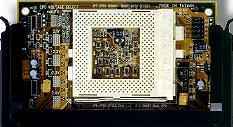Soltek SL-02A++ Slocket Adaptor
Review
 There have lately been a wave of FC-PGA / PPGA
adapters on the market, especially these days due to the recent release of the
Intel "Coppermine" CPU. The Coppermine is the latest edition of the Pentium III
family which is manufactured on a .18 micron process as opposed to the older
generation Pentium III's manufactured on a .25 micron process.
There have lately been a wave of FC-PGA / PPGA
adapters on the market, especially these days due to the recent release of the
Intel "Coppermine" CPU. The Coppermine is the latest edition of the Pentium III
family which is manufactured on a .18 micron process as opposed to the older
generation Pentium III's manufactured on a .25 micron process.
Coppermine's have introduced a 256KB
on die L2 cache running at full clock rate. Previously, Pentium III's were
running on a half clock speed 512KB cache. Because of this and the shift to .18
micron, Intel has given people something great to look forward to... including
overclockers.
Now a couple of inherent problems
are there when wanting to shift to the Coppermine. On October 25, 1999, Intel
announced the FC-PGA form factor, so motherboards made prior to that date may
not have support for the Coppermine. Firstly, being based on a .18 micron
process had brought down voltage requirements. Coppering run at a voltage of
either 1.6 or 1.65 volts. Current Celeron processors operate at 2.0 volts.
Secondly, FC-PGA Coppermine's
have two RESET pins and operate according to VRM 8.4 specifications (check your
motherboard for compliance). Coppermine's also run at a 133Mhz FSB speed which
the majority of motherboards do support. Lastly the motherboard you which to
use the Coppermine on must have a supporting BIOS to avail of proper detection
of the chip. To be absolutely certain, do check with the motherboard
documentation or the manufacturer itself if the BIOS and motherboard do support
Coppermine CPUs.
Specifications
Recently,we got our hands on the Soltek
SL-02A++ FC-PGA / PPGA Adapter card (or known as Slocket to many). Here below
are the specifications of the adapter card:
- Allows for FC-PGA &
PPGA processors to plug into Slot 1
- Supports for Intel's Coppermine and the
upcoming VIA Cyrix Joshua processor
- 32 CPU core voltage settings jumpers
(from 1.3V to 3.5V)
- Support for 66/100/133 Mhz FSB
- Support for dual
Slot 1 motherboards
Now before making the shift make sure that your
motherboard has support for a 133Mhz FSB, VRM8.4 specification and a BIOS which
can detect the presence of a Coppermine CPU. Of course, another important aspect
would be to use PC133 SDRAM. It is well known that some varieties of PC100 SDRAM
can be clocked at speeds of (and sometimes greater than) 133Mhz. All this can be
confusing for some, but that is the way of the industry. So right now we are
stuck with it.
So then why not go in for a FC-PGA motherboard in the
first place? Well, the Coppermine is still prohibitively expense for most and it
hasn't quite caught on yet. So purchasing a Coppermine compliant
Slot 1 motherboard right now will gain you the opportunity to use your older, say,
SEPP Celeron and still have an option for upgrading to a Coppermine at a
later date through the use of a Slocket adapter like the one
reviewed here.
Or you just may
want the flexibility just for the heck of it! In the future, motherboard
manufacturers will start concentrating more towards the Socket 370 platform
rather than the Slot 1 since it is more cost effective to manufacture. But leave
aside that, it looks like Intel itself is moving more towards Socket 370 as
well. So there isn't much choice for the motherboard manufacturers now, is
there? ;)

